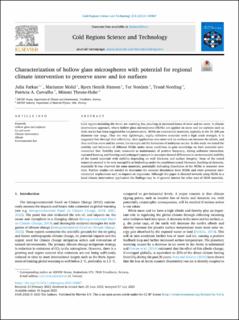| dc.contributor.author | Farkas, Julia | |
| dc.contributor.author | Aune, Marianne | |
| dc.contributor.author | Hansen, Bjørn Henrik | |
| dc.contributor.author | Nordam, Tor | |
| dc.contributor.author | Nordtug, Trond | |
| dc.contributor.author | Almeida Carvalho, Patricia | |
| dc.contributor.author | Throne-Holst, Mimmi | |
| dc.date.accessioned | 2024-01-23T09:21:13Z | |
| dc.date.available | 2024-01-23T09:21:13Z | |
| dc.date.created | 2023-10-13T07:58:58Z | |
| dc.date.issued | 2023 | |
| dc.identifier.citation | Cold Regions Science and Technology. 2023, 215: 103967. | en_US |
| dc.identifier.issn | 0165-232X | |
| dc.identifier.uri | https://hdl.handle.net/11250/3113257 | |
| dc.description.abstract | Cold regions including the Arctic are warming fast, resulting in increased losses of snow and ice cover. A climate intervention approach, where hollow glass microspheres (HGMs) are applied on snow and ice surfaces such as Artic sea ice has been suggested for ice preservation. HGMs are commercial materials, typically in the 10–200 μm diameter size range. They are very lightweight, highly reflective materials with a high crush strength. It is suggested that through that reflectivity, their application onto snow and ice surfaces can increase the albedo, and thus stabilize snow and ice covers, for example aid the formation of multiyear sea ice. In this study we tested the stability and behaviour of different HGMs under stress conditions to gain knowledge on their potential environmental fate. Stability tests, measured as maintenance of positive buoyancy, during sediment interaction, repeated freezing and thawing and prolonged exposure in seawater showed differences in environmental stability of the tested materials with stability depending on wall thickness and surface integrity. None of the tested materials seemed to be very susceptible to biofouling under the conditions tested. However, leaching of elements, especially Si was observed for some materials, potentially indicating dissolution of the HGMs in seawater over time. Further studies are needed to determine the element dissolution from HGMs and other potential environmental implications such as impacts on organisms. Although this paper is directed towards using HGMs in a local climate intervention application the findings may be of general interest for other uses of HGM materials. | en_US |
| dc.language.iso | eng | en_US |
| dc.publisher | Elsevier | en_US |
| dc.rights | Navngivelse 4.0 Internasjonal | * |
| dc.rights.uri | http://creativecommons.org/licenses/by/4.0/deed.no | * |
| dc.title | Characterization of hollow glass microspheres with potential for regional climate intervention to preserve snow and ice surfaces | en_US |
| dc.title.alternative | Characterization of hollow glass microspheres with potential for regional climate intervention to preserve snow and ice surfaces | en_US |
| dc.type | Peer reviewed | en_US |
| dc.type | Journal article | en_US |
| dc.description.version | publishedVersion | en_US |
| dc.rights.holder | © 2023 The Authors. Published by Elsevier. | en_US |
| dc.source.pagenumber | 8 | en_US |
| dc.source.volume | 215 | en_US |
| dc.source.journal | Cold Regions Science and Technology | en_US |
| dc.identifier.doi | 10.1016/j.coldregions.2023.103967 | |
| dc.identifier.cristin | 2184301 | |
| dc.source.articlenumber | 103967 | en_US |
| cristin.ispublished | true | |
| cristin.fulltext | original | |
| cristin.qualitycode | 2 | |

